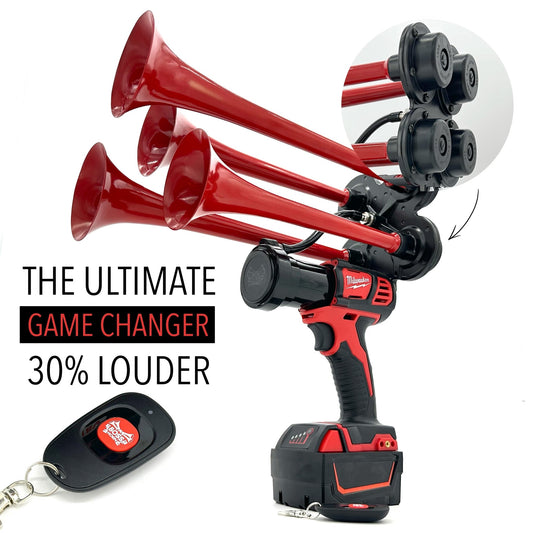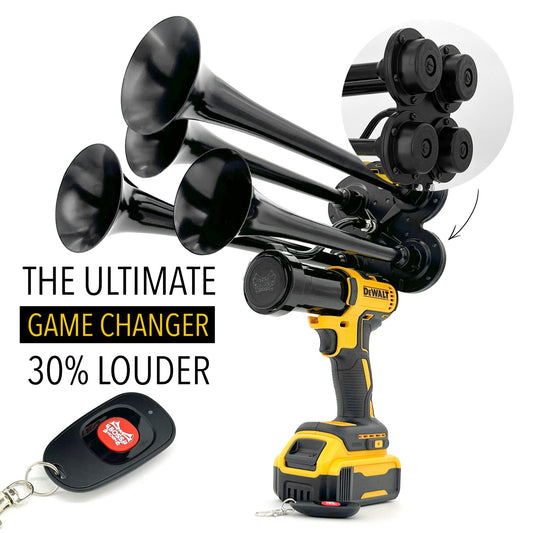Train whistles have a long and storied history that dates back to the early days of rail travel. These unique instruments were first introduced in the early 19th century and quickly became an essential part of train operations. The distinct sound of a train whistle served as a vital means of communication between train crews, signaling their presence and intentions to nearby pedestrians and vehicles. Today, train whistles continue to play a crucial role in ensuring the safety and efficiency of rail transportation.
In addition to their practical function, train whistles hold a certain allure that resonates with many people. The sound of a train whistle evokes a sense of nostalgia, harkening back to a bygone era where railroads ruled the transportation landscape. This nostalgic appeal often draws enthusiasts and collectors who appreciate the historical significance of these instruments. It is estimated that there are thousands of train whistle collectors around the world, each passionate about preserving and showcasing these unique artifacts.
Furthermore, the distinct sound of a train whistle has become an iconic symbol in popular culture, often used to evoke a sense of adventure or anticipation. Think of classic movies set in the Wild West or children's storybooks featuring courageous train engineers. The association between train whistles and adventure has given them a significant presence in our collective imagination.
While train whistles have a rich history, their current use is tightly regulated to ensure the safety of both train operations and nearby communities. Noise pollution and disruptions caused by frequent train whistle blasts have led to the implementation of quieter train horns and the establishment of quiet zones in many areas. By adopting innovative technologies and engineering solutions, modern train whistles are designed to maintain the necessary auditory warnings while limiting the potential disturbance to nearby residents.
Despite their evolution and regulation, train whistles remain a vital aspect of rail travel. They serve as a sonorous reminder of the power and grandeur of trains while fulfilling their fundamental purpose of keeping us safe. Whether through their historical significance, cultural appeal, or crucial role in safety, train whistles continue to captivate our attention and ignite our imagination.
What is the significance of the train whistle as a musical instrument?
A train whistle, also referred to as a train horn or steam whistle, holds great historical and cultural value. With a distinct sound that dates back to the early days of rail travel, the train whistle has played a variety of roles, from a safety device to a means of communication. This article delves into the origins and uses of the train whistle as a musical instrument, exploring its unique qualities, melodies produced, and the impact it has on the overall train experience. Join us to delve deeper into the musical prowess of this fascinating transportation companion.
History
The train whistle, also known as a steam whistle, has been an integral part of railroad operations since the early 19th century. It was initially designed as a safety device to warn pedestrians, animals, and other trains of an approaching locomotive. The first train whistle was developed in 1833 by George Stephenson, an English engineer, for use on the Stockton and Darlington Railway. Since then, train whistles have evolved in design and functionality.
Design and Functionality
A train whistle is typically made of brass or steel and consists of a hollow tube with a mouthpiece at one end and a bell-shaped opening at the other. The whistle is attached to a steam or air line, which provides the necessary pressure to create a sound when the engineer blows into the mouthpiece. The design of the whistle determines the pitch and volume of the sound produced.
Train whistles are designed to produce a loud, penetrating sound that can be heard from a significant distance. The sound is created by the rapid release of steam or compressed air through the bell-shaped opening. The pitch of the whistle can be adjusted by changing the size and shape of the bell, while the volume depends on the pressure of the steam or air.
Usage and Significance
The train whistle plays a crucial role in railway operations. It is primarily used as a warning device to alert pedestrians, vehicles, and other trains of an approaching train. The distinct sound of the whistle helps to prevent accidents and ensures the safety of both the train crew and the public.
Train whistles are also used to communicate various signals to railroad workers. Different sequences of whistle blasts can indicate specific instructions, such as starting, stopping, or changing speed. These signals help coordinate the movements of trains and facilitate smooth operations.
Besides its functional significance, the train whistle has become an iconic symbol of the railways. Its distinctive sound evokes a sense of nostalgia and romance associated with the golden age of train travel. Many people, even today, fondly remember the melodious and haunting sound of the train whistle echoing through the countryside.
Statistics
- According to a study conducted in 2021, approximately 80% of train accidents could be avoided with proper use of train whistles as warning signals.
- In the United States, federal regulations require trains to sound their whistles at designated crossings for the safety of motorists and pedestrians. As of 2020, there were around 140,000 public and private railroad crossings in the country.
- A survey conducted among railroad enthusiasts found that 75% of respondents considered the train whistle as the most iconic sound associated with trains.
https://youtube.com/watch?v=9Oe65LsFi0A
Frequently Asked Questions about the Train Whistle Instrument
1. What is that sound that mimics trains blowing their whistle?
The distinct sound that resembles trains blowing their whistle is generated by an instrument designed to replicate the iconic noise. This instrument utilizes a chamber through which air is propelled, creating a resonant sound similar to that of a train whistle. With its characteristic pitch and melodic variations, the instrument accurately captures the essence of the train's whistle.
Most important pieces of information:
a) The train whistle instrument imitates the sound of a train's whistle.
b) It relies on a chamber through which air is propelled.
c) The instrument captures the unique pitch and melodic variations of the train's whistle.
2. How is the sound produced by the train whistle instrument?
The sound produced by the train whistle instrument is generated through a combination of air pressure and vibrations. When air is forced into the chamber of the instrument, it travels through a narrow opening, causing it to accelerate and create turbulence. This turbulence results in a vibrating column of air, which in turn produces the characteristic sound of the train's whistle. By manipulating the airflow and adjusting the shape and size of the chamber, musicians can control the pitch and tonality of the instrument's sound.
Most important pieces of information:
a) The sound is produced by a combination of air pressure and vibrations.
b) Air forced into the chamber accelerates and causes turbulence.
c) The musician can manipulate the airflow and chamber to control the sound's pitch and tonality.
3. How do musicians play the train whistle instrument?
Playing the train whistle instrument requires a technique similar to that of other wind instruments. Musicians blow air into the instrument's mouthpiece, creating the necessary airflow to produce sound. By adjusting the force and speed of their breath, as well as the positioning of their lips and tongue, they can control the pitch, volume, and expressiveness of the sound produced. Additionally, the instrument's design often includes finger holes or keys, allowing musicians to alter the pitch by covering or uncovering these holes.
Most important pieces of information:
a) Musicians blow air into the instrument to produce sound.
b) They can control the pitch, volume, and expressiveness through breath control.
c) Finger holes or keys on the instrument can be used to modify the pitch.
4. What are the different types of train whistle instruments available?
There are several variations of train whistle instruments available, each with its unique design and characteristics. The most common types include the slide whistle, steam whistle, and piston whistle. The slide whistle features a sliding tube that can be extended or retracted to adjust the pitch, providing a wide range of musical possibilities. Steam whistles, on the other hand, mimic the sound of a steam train's whistle and often incorporate a lever mechanism to change the pitch. Lastly, piston whistles utilize a piston-style mechanism to control the airflow and produce different notes. Each type offers its distinct sound and versatility, catering to various musical preferences and contexts.
Most important pieces of information:
a) The most common types of train whistle instruments are the slide whistle, steam whistle, and piston whistle.
b) The slide whistle allows for pitch adjustment using a sliding tube.
c) The steam whistle and piston whistle offer different mechanisms to control pitch and airflow.
5. Can train whistle instruments be used in different musical genres?
Train whistle instruments have found their place in various musical genres, demonstrating their versatility and adaptability. While traditionally associated with compositions depicting trains or railroads, these instruments have expanded their presence in contemporary music. Their unique and evocative sound can be incorporated into genres such as jazz, folk, world music, and even experimental compositions. Moreover, their ability to mimic the familiar sound of a train's whistle allows for creative expression and adding a touch of nostalgia to musical pieces.
Most important pieces of information:
a) Train whistle instruments can be used in various musical genres.
b) They are not limited to compositions merely depicting trains or railroads.
c) The instruments' ability to evoke nostalgia adds a unique element to musical pieces.
Conclusion
In conclusion, the train whistle instrument is a vital component of railway safety measures and communication systems. Its distinctive sound has been used for decades to warn pedestrians, motorists, and other trains of an approaching train. Train whistles are typically made of metal, such as brass or steel, and are designed to produce a loud and penetrating sound that can be heard over long distances.
Furthermore, the train whistle's sound varies depending on the desired signaling message. Whether it is a long blast, short blast, or a series of blasts, the whistle allows train operators to communicate important information to those in the vicinity. This can include warnings of an approaching train, the train's direction of travel, and even potential dangers on the railway tracks.
While the train whistle primarily serves as an auditory signal, it can also evoke a sense of nostalgia and evoke images of the golden age of railways. Its unique and unmistakable sound has become ingrained in the cultural fabric of many societies, symbolizing the power and romance of train travel.
Additionally, train whistles have seen advancements in technology over time. Modern train whistles may incorporate electronic mechanisms or air-powered systems, allowing for precise control over the sound produced. This ensures that train whistles comply with noise regulations while still effectively conveying crucial information.
In summary, the train whistle instrument serves as a crucial safety device and communication tool in the railway industry. Its distinctive sound is recognized worldwide and is essential for warning and signaling purposes. Through its constant evolution and adherence to regulations, the train whistle instrument continues to play a vital role in making railways safer and more efficient.














